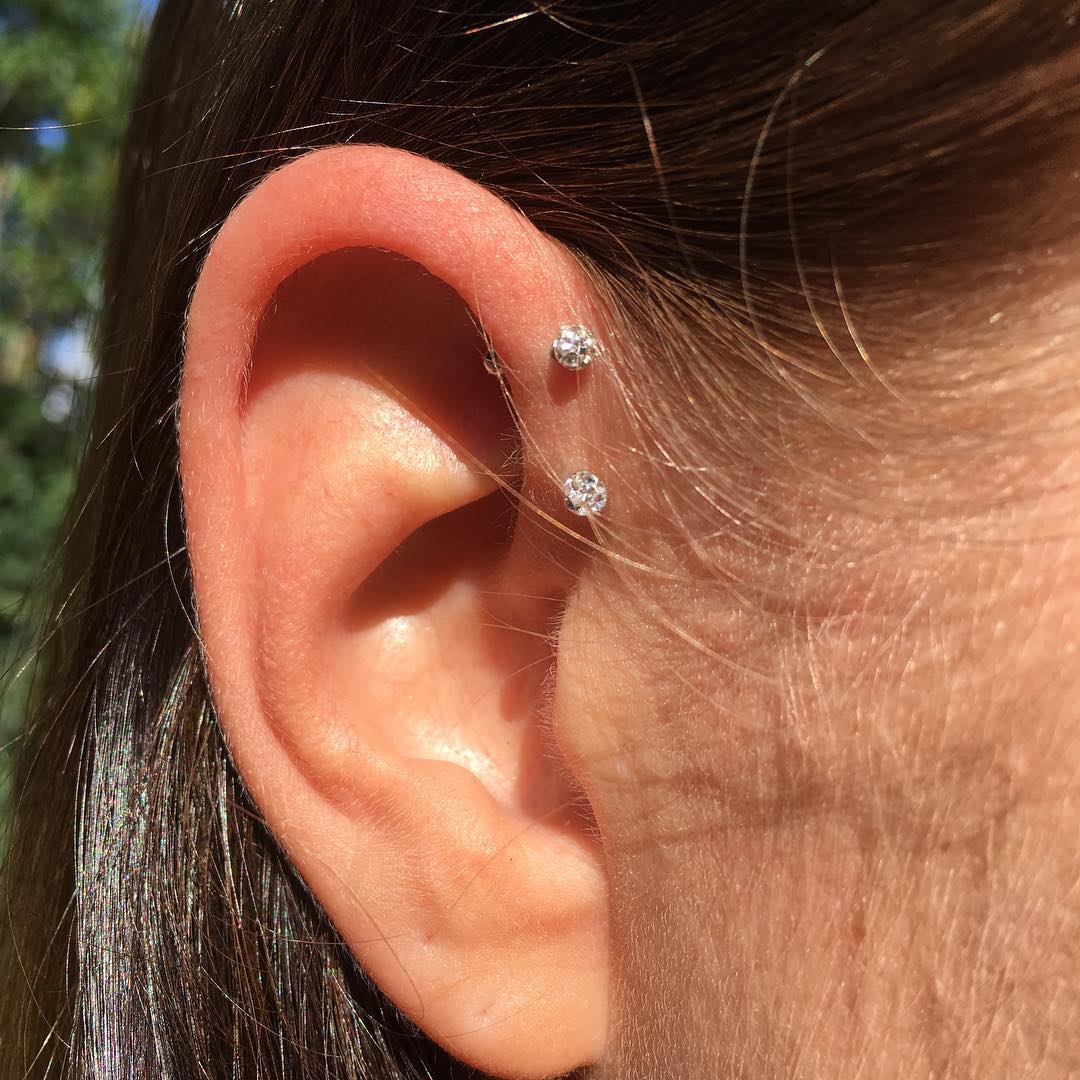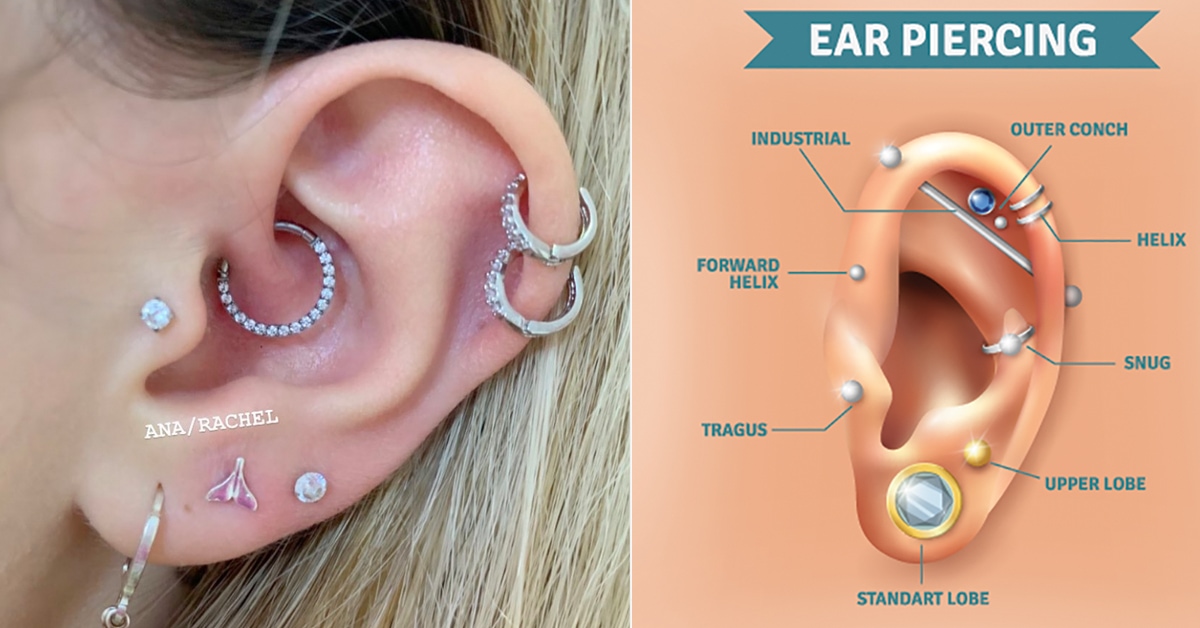
Forward helix, anti helix, seconds, rook, septum, Piercing Tattoo
The snug piercing, also known as an anti-helix piercing, will go through the cartilage in your ear called. you guessed it, the anti-helix. The anti-helix is the little ridge in your ear that lies above the lobe and underneath the top part of the ear. The larger this piece of cartilage is, the easier it will be to pierce! Snug Piercing Process:

Helix Piercing 50+ Picture Ideas. Helix Piercing Ideas Female
It passes through an area called the anti-helix, also known as the stem of your ear — that sliver of cartilage in between ear canal and your outer cartilage.

pictures double lobe and inner helix piercings double anti helix helix
The snug piercing, also called the anti-helix piercing, is a newer piercing type. While it sits in a similar location to the auricle ear piercing, the entrance and exit points of the snug piercing both appear at the front of the ear, so it'll be more aesthetically similar to a rook piercing.

60 Best Forward Helix Piercing Ideas Try Something New[2019]
Helix piercings can take up a to a year to heal Shutterstock According to pro piercer Kevin Lamb, helix piercings can take anywhere from three months to a year to heal, admitting he'll never do more than three piercings at a time, as the healing can take even longer.

Mackenzie came by today for a new Triple Forward Helix! Keeping it
the Anti-Halix piercing also called " Forward Helix "Is so called because it is in front of the helix, the part that forms a tube surrounding the pavilion of your ear. So he comes to place himself at the end of the helix just above the tragus.

Pin by Laura DeLeon on accessories Earings piercings, Cool ear
The two most popular variations of this piercing include the forward helix piercing, a forward-facing piercing above the tragus and on the ear's upper cartilage, and the anti-helix or snug.

Industrial bar, forward helix, triple lobe Earings piercings, Cute
Lacy says prevention is the best medicine to keep your piercing from getting re-infected. She recommends avoiding touching your piercings unless you are changing the jewelry or cleaning the area.

Ear piercing. Tragus. Anti tragus. Helix. Forward helix. Double helix
For the snug piercing we recommend using a curved barbell or piercing ring. The standard bar thickness for an anti-helix piercing is 1.2 mm. The standard diameter is 6 mm, but 8 mm is also a common choice. Although most piercing rings can fit in the anti-helix, an oval shaped ring can be more comfortable to wear in an anti-helix.

What Is a Helix Piercing? Here's Your Ultimate Guide Let's Eat Cake
A lobe piercing, or earlobe piercing, is any piercing that goes through the fleshy lower part of the ear—basically where you got your very first ear piercings (most likely). All four of these piercings are lobe piercings. Healing time: 6-8 weeks. Image via @maria_tash helix-piercing HELIX PIERCING

Conch Piercing Forward Helix Piercing earpiercings Daith Piercing
Forward helix: Also known as an "anti-helix" piercing, this is located horizontally across from the standard helix piercing, on the cartilage at the front of the ear (closest to the face). Placement depends on the shape of the cartilage on your ear.

Anti Helix And Lobe Piercing On Ear
Additionally, it can be referred to as the anti-helix or inner-helix piercing. Triple and double forward helix There will be two more studs ascending from the initial forward helix, resulting in a three-stud line. In the case of a double forward helix piercing, there are two studs in total. Helix piercing

Pin on Piercings
Additionally, piercings in the cartilage of the ear, which lacks an adequate blood supply, makes it more difficult to heal than locations that receive better circulation such as the lobe. The snug piercing is no exception to the long-term healing process that comes with most cartilage piercings.

Stainless steel earring for double piercing. helix cartilage
A helix piercing is also called a cartilage piercing because of its location somewhere on the outer cartilage of your ear. There are several variations on the piercing, including the forward helix, double helix, triple helix, and anti-helix ( or snug) piercings—what differentiates the types is where they're located on the ear.

Pin on piercings
The antihelix ( anthelix) is a part of the visible ear; the pinna . The antihelix is a curved prominence of cartilage parallel with and in front of the helix on the pinna. The antihelix divides above into two legs or crura; the crura antihelicis, between which is a triangular depression, the fossa triangularis . External ear. Right auricle.

Pin by Heidi Pattieshaw on Piercing Anti helix piercing, Helix
The helix piercing Photo by A deemproduction The helix piercing is probably the second most popular ear piercing. It takes place in the cartilage at the outer rim of the ear right below the apex. Like the lobe piercing, the helix piercing offers plenty of space to pierce, so it's not uncommon to see multiple helix piercings.

Helix Piercing Body Piercing Magazine
Similar to how the helix is the C-shaped edge of the ear, there's a parallel C-shaped ridge on the inner ear with several piercing locations of different names: snug/anti-helix, rook, daith, conch, and anti-tragus. Anti-helix/snug. The anti-helix, also called the snug, is located midway through the ear's inner ridge.